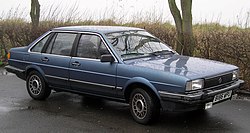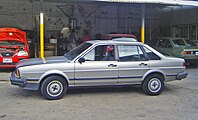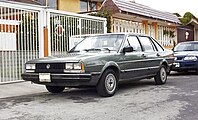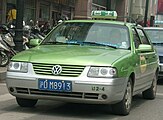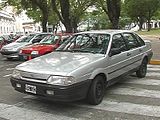VW Santana B2
| Volkswagen | |
|---|---|
|
VW Santana (1981-1984)
|
|
| Santana | |
| Production period: | 1981–1984 (outside Germany: until 2010) |
| Class : | Middle class |
| Body versions : | limousine |
| Engines: |
Otto engines : 1.3–2.1 liters (44–85 kW) Diesel engines : 1.6 liters (40–51 kW) |
| Length: | 4545 mm |
| Width: | 1685 mm |
| Height: | 1385 mm |
| Wheelbase : | 2550 mm |
| Empty weight : | from 1050 kg |
| successor | VW Passat Notchback (Germany), VW Santana 2000 |
The VW Santana is a model of the Volkswagen brand that was offered from September 1981 to the end of 1984 . It is a four-door sedan with a notchback on the platform of the second generation VW Passat B2, which appeared in October 1980 . The Santana B2 should round off the VW offer towards the upper middle class.
The B2 with notchback successfully fulfilled the role of the “world car” for Volkswagen in the 1980s. The Santana belongs to the group of vehicles produced by Volkswagen most frequently as well as to the group with the longest production cycles.
Model history
General
The name "Santana" is derived from the California Santa Ana winds . The Santana was technically derived from the Passat. It was positioned a little higher than the Passat, this showed the higher quality equipment and the better interior materials. The distinctive features of the Passat were the noticeable notchback, a different radiator grille with white indicator glasses right next to the headlights (on the Passat the indicators were in the bumper) and the chrome trim. In addition, a Santana differed from the Passat in many other, higher-quality details.
Volkswagen wanted to position the Santana higher than the Passat, which not only thwarted the external similarity to the Passat. Test reports in which the Santana was simply described as an overpriced Passat version, reduced the sales success. In Germany, the Santana faced established competition from BMW and Mercedes-Benz and the well-established mid-range products from Audi ( Audi 80 and Audi 100 ): On the one hand, the Audi vehicles were established in this segment, on the other hand, Audi only served the Middle and upper class. In addition, the Audi and VW models were marketed via a joint sales channel: The number of units remained well below VW's expectations.
From January 1985 the name Santana was given up in Europe (except in Spain), but the car itself continued to be sold under the name “Passat Notchback” after a facelift (front now in Passat style, modified bumpers). Despite its undisputed qualities (trunk, purchase price), the Santana could not meet the planned sales figures in Germany and Europe.
In March 1988, production in Emden ceased together with that of the Passat B2. Nevertheless, the concept on which the Santana is based cannot be regarded as a failure, because since 1988 the VW Passat has only been available with a notchback (as a Santana successor, so to speak) and as a variant.
Versions / equipment
In the first year of construction, the Santana was only offered in the higher-quality CL and GL versions. In order to underline the independence of the model, the model names were changed from August 1982 (model year 1983) to LX and GX, and from model year 1984 onwards, the range was supplemented by a CX with reduced scope.
The engine range consisted of four-cylinder petrol engines of 1.3, 1.6 and 1.8 liters displacement (60-90 hp), and there was also a 1.9-liter five-cylinder (115 hp) from 1981 to 1983, the was then replaced by a two-liter five-cylinder injection engine from Audi of the same power. A naturally aspirated diesel engine (54 hp) and a turbodiesel (70 hp) each with a size of 1.6 liters were available as diesel engines .
In the wake of rising fuel prices, VW was forced to implement measures to reduce fuel consumption in the early 1980s and introduced the Formula E models. These models were equipped with minor aerodynamic improvements and longer gearboxes. The Passat and Santana Formula E also featured a start-and-stop system that enabled the driver to switch off the engine at the push of a button, for example when stopping at traffic lights. The engine then started automatically when the first gear was engaged. Similar systems were not found again until years later in the Golf III Ecomatic, in the Citroën C3 and in the models from BMW with the Efficient Dynamics package.
In the Santana (as in the VW Golf , Jetta and Passat) emissions-reducing measures with a regulated catalytic converter ("US standard") were introduced from September 1984. Upon request, the customer received the special 1.8-liter injection engine with lambda control as an "accessory pack", that is, with the parts in the trunk required for later operation with unleaded petrol, prepared for later installation, once unleaded is available everywhere Petrol in the Federal Republic of Germany.
The VW Santana as a world car
General
Although the Santana did not have the desired market success in Germany, the concept was very popular in other markets: the car was produced or assembled at the same time in Germany, Brazil, China, Belgium, Mexico, Argentina, Japan, Namibia and South Africa and on all continents except Australia and Antarctica. In China, the model was still available in the form of the VW Santana Vista 2019.
The Santana in Brazil
The Santana was more successful than in Germany at Volkswagen do Brasil and in the People's Republic of China . The Santana was built in Brazil from 1984 to 2006, where it developed into the most successful car in the upper middle class. This is all the more understandable when you consider that the competition in Brazil at the time initially consisted of the Chevrolet Opala , an adapted version of the Opel Rekord C , which had long since been replaced in Germany , and the Ford Maverick , a deliberately primitive (i.e. inexpensive) built Compact car that had also long since been superseded in North America. In Brazil, the Santana was also available with two doors, a variant that was never offered in Europe because the time for two-door models of this size in Europe was almost up in the 1980s. In 1995 the VW Santana 2000 was actually introduced in Brazil, although the previous name was retained.
In Brazil the Santana was also available as a Variant, it essentially corresponds to the German VW Passat Variant. In Brazil, the variant was initially called Santana Quantum, later just Quantum; the production of the Quantum in Brazil was stopped in 2003, in June 2006 the Santana was completely taken out of production there.
At the time of the Autolatina , a strategic cooperation between VW and Ford, this VW was also available with stylistic modifications as Ford Versailles and Royale , the former a four-door sedan, the latter a two-door station wagon.
The Santana in China
In the PR China - after the first trial assemblies from April 11, 1983 - the Santana has been built continuously since 1985 by Shanghai Volkswagen , a joint venture between VW and SAIC . From 1995 the revised version was called VW Santana 2000 , since a facelift in 2004 the VW Santana 3000 and its luxury version VW Santana Vista .
The vehicle is particularly popular as a taxi and is still one of the best-selling cars in China at the end of 2010. This is partly due to the legal minimum size of the cubic capacity of 1.6 l for taxis - a corresponding regulatory situation has been introduced in some provinces, and the Santana is therefore preferred over domestic competitors, those with a smaller body, which is conditionally suitable for the taxi trade, and with smaller displacement were available.
In 2013, a newly developed version was released in China . The Gran Santana hatchback version was presented at Auto Shanghai 2015 .
The Chinese Shanghai SH760 , built parallel to the Santana, was further developed into the Shanghai SH7221 in the 1980s as a result of the cooperation with VW using some Santana components .
The Santana in Japan
From February 1984 to 1990, was Santana by Nissan in Japan produced under license. The vehicles there were sold by Nissan dealers as "Volkswagen Santana" and were assembled from parts largely Japanese-made, which, in addition to Volkswagen and Audi logos, also display the Nissan logo. A 1.8-liter four-cylinder (73 kW / 100 PS), a two-liter five-cylinder (81 kW / 110 PS, from 1987 also with two overhead camshafts, four-valve technology (special "Autobahn" model) and 103 kW / 140 PS were offered ) and a 1.6-liter turbo diesel (specified in Japan with 53 kW / 72 PS).
The Santana in the USA
In North America, both Passat B2 and Santana were sold from 1981 to 1988 under the name “VW Quantum”, the three-door hatchback as “VW Quantum Coupe”. The vehicles were initially powered by the USA-specific 1.7-liter four-cylinder (1715 cm³, 55 kW), on request also by the 1.6-liter turbodiesel (here 69 hp) and from model year 1984 on by a 74, later 82 kW, 2.1-liter five-cylinder.
Individual evidence
- ↑ VW Santana Formula E at http://www.santanagx5.de. Retrieved January 23, 2017 .
- ↑ 30 years of dancing with the dragon. In: handelsblatt.com , accessed on April 18, 2017.
- ↑ VW Santana is reissued. VW brings the small, cheap Passat to the Chinese Focus Online from October 30, 2012, accessed on September 4, 2013
- ^ Mike Covello, Standard Catalog of American Cars 1946-2002. Krause Publications, Iola 2002, ISBN 0-87341-605-8 , p. 828ff.
swell
- Werner Oswald: Deutsche Autos 1945–1990 , Vol. 3. Motorbuch Verlag, Stuttgart, 2nd Edition 2003, ISBN 3-613-02116-1 , pp. 145–157.
